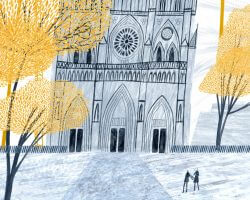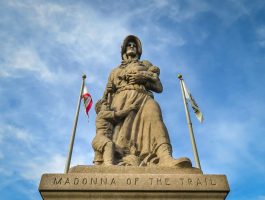Support Hidden Compass
We stand for journalism, science, history, and hope. Make a contribution to Hidden Compass and stand with us.
One second, she was right beside me. The next, she was hurtling toward the drummers, her arms circling through the air, and her feet pounding out rhythmic triple steps on the dry earth. The green, patterned fabric of the woman’s long wrap skirt splayed out around her, accenting her movements. Somehow, her well-worn flip-flops stayed glued to her feet.
She kept low to the ground with her knees bent, back straight, and head up, like a basketball player dribbling past her competition. Her twists and turns sent dust into the night air. The specks of dirt shimmered under the illumination of the single lightbulb strung between the surrounding mud-and-cinder-block houses.
It didn’t take long for the gathered crowd to notice her, and soon dozens of heads had turned in her direction.
Then the lead drummer saw her coming. He stood up straight and took a few bold steps toward her.
Three loud cracks of his carved, cowskin-topped drum welcomed her arrival. He locked eyes with the woman.
This was her moment, and she was ready.
As I watched from the sidelines, my mind slipped to a dance floor back home and a sensation I know well — moving as one with a partner to a Duke Ellington song. Holding my lead’s hands lightly, I followed him closely, reacting to the way he tensed his body and how his feet translated the syncopated notes. As we co-created the dance, the two of us — to our surprise and delight — landed on the same traditional jazz move at the peak of the music.
I thought I recognized a similar sort of uncanny unison taking hold of the artists in front of me. But the expression of dance unfolding before me seemed to be guided by so much more than the rhythm of the drum.
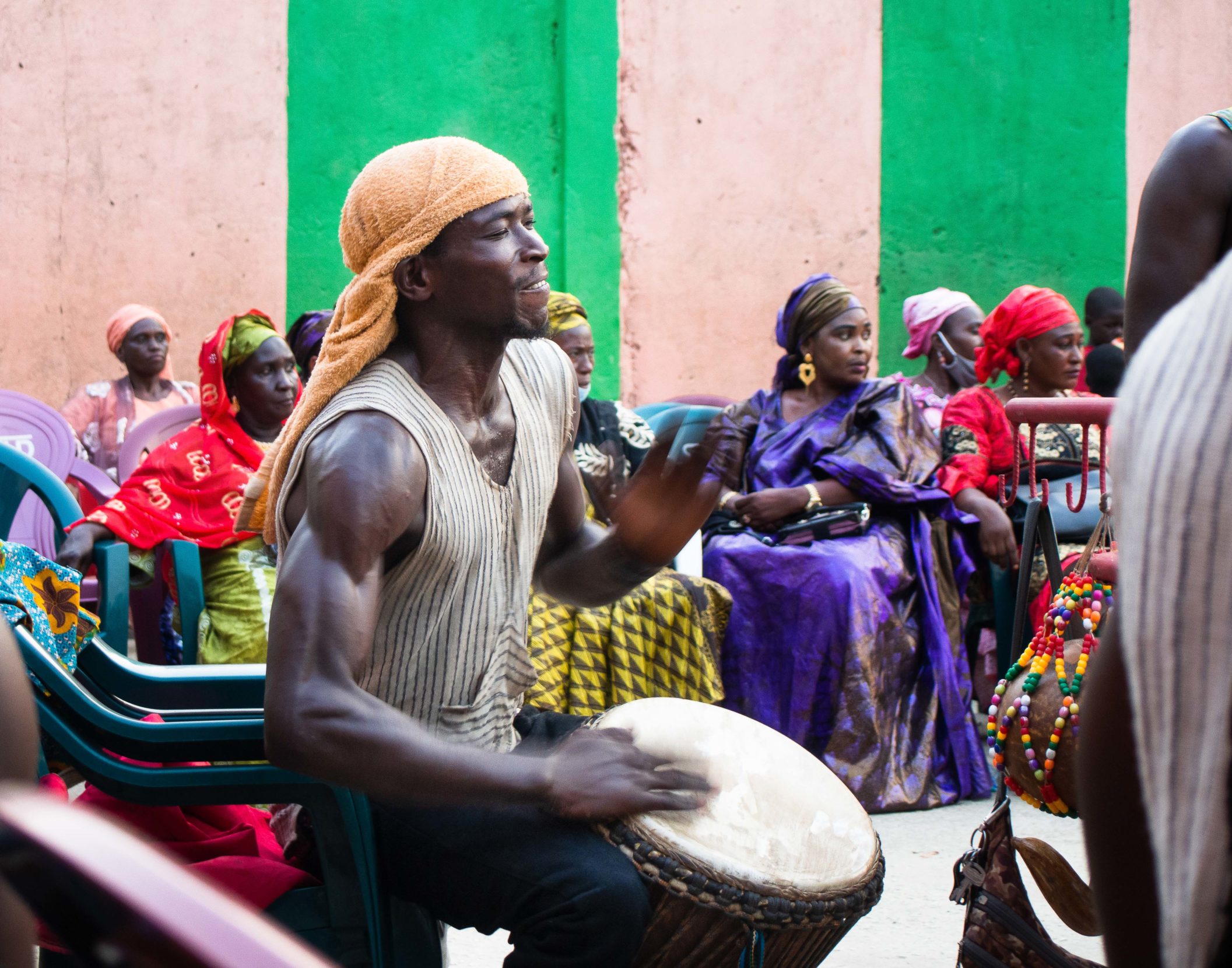
Drummer Mamoudou Keita plays the djembe at a traditional pre-wedding ceremony in Conakry, Guinea. His father performed as a soloist of Les Ballets Africains. Photo: Aki Natori.
~~
Two weeks earlier, there had been another loud crack of a drum. The year was 2014, and I had come to the West African country of Guinea to attend a dance camp. Though excited to be there, I wasn’t sure if I was ready for what was to follow.
Large tarps hung overhead. They kept the direct sun off my pale skin, but they didn’t do much to mitigate the heat. I’d already sweat through my tank top.
I stood barefoot in a cement courtyard in the capital city, Conakry, to learn doundounba, the dance of the strong man. A large cement and metal gate fenced in the compound where our practices would take place. A guard wearing a forest green uniform rested casually in a lawn chair near the entrance, his rifle propped up against him.
The lead djembe player sat behind his goblet-shaped drum. He shouted something to the musicians in a local language, Maninka, and then the traditional intro to the song began. Together, the instruments were so loud my eardrums ached; each metallic slap of the djembe delivered an additional sting.
The toilet paper I’d stuffed into my ears before class helped mitigate the sound — the deep resonance of the big doundounba drum, as well as the other, smaller bass drums, sangban and kenkeni. High-pitched bells accompanied the driving rhythm.
I bounced up and down a bit, moving my weight to the balls of my feet and assuming a hip-width stance, with my feet just beyond my shoulders. Bending diagonally forward from the hips, I then held an athletic posture that poised me for the quick turns, jumps, and rhythm changes to come.
Do I know what it means to give myself entirely to a dance?
Nearby, a cook washed dishes in a large plastic tub, the water sloshing as she rinsed the red plastic plates we used for breakfast. Children started gathering near us, mimicking our movements.
I began to step to the pulses of the music, doing my best to embody the confidence and vigor necessary to the dance. Modeling a signature doundounba move, the instructors bent their arms and undulated them up and down to each beat of the music. Their elbows never went above their shoulders, giving the gesture a powerful, yet contained, appearance.
I tried my best to copy this and the moves that followed, but my arms went forward when they should have gone back. I was often much too upright and, when I tried to throw my head back to accent the moves, I missed the ensuing turns.
If our teachers resembled warriors psyching themselves up for battle, I looked like an awkward teenager with no business defending the community.
~~
“What inspired you to come to Guinea?” Mamadama Bangoura, the head dance teacher, asked me in French my first morning in the country. She was wearing a hot pink top, matching leggings, and a red-and-white sash tied around her waist. Her hair was pulled back in a bun and her feet were bare.
The morning air was already warm and sticky, and I felt woozy from the heat. Drummers milled about the courtyard, casually chatting with one another.
“West African traditions are core to the dances I teach in the United States,” I responded slowly, summoning the French I’d learned years earlier in college. Mamadama maintained steady eye contact, which made me feel encouraged to go on despite my rusty language skills.
I had flown across the Atlantic to explore the roots of Lindy Hop — an original form of swing dancing — and other American jazz forms that originated in Black communities in Harlem in the late 1920s.
Many of the original Harlem dancers descended from West Africans who had been kidnapped and brought to the United States throughout the 17th, 18th, and 19th centuries. Although they lost their homes, they brought their traditions. Their dances, however, quickly became co-opted for nefarious purposes.
During the transatlantic journey, captors often forced enslaved peoples to dance on the ships, trying to make sure they would maintain the healthy appearance that would fetch a higher price on the slave market.
Once they arrived in the United States or the Caribbean, the enslaved peoples were sometimes required to dance for Southern plantation owners. This led to the beginning of a fusion of styles, as the beautiful dance traditions of many African peoples combined with European influences that were witnessed in their new surroundings.
For instance, the cakewalk merged the stylings of a European partner dance known as the Grand March with twists, high kicks, and other West African-style movements. Dressed in finery, the performers parodied the mannerisms of their enslavers under the guise of a lighthearted performance.
This veiled act of resistance ultimately morphed again into a mainstay of minstrel shows, often put on by white performers who didn’t get the joke. Within African communities, though, the paired-up moves of the cakewalk marked the beginning of the partner dancing that became core to Lindy Hop.
With this history in mind, I was eager to learn more about the roots of the dance I so loved, as well as see how the traditions had evolved in their native setting.
“I want to better understand the culture here,” I continued, “so I can show my respect for the art form and become a better instructor.”
“Mmm,” Mamadama responded, nodding. “I will help you.”
Her energy — as well as her vibrant style — put me at ease, but it was hard not to feel intimidated: Before me stood a principal dancer for the renowned Les Ballets Africains, the first national dance company in all of Africa. The privilege to study with her was all the rarer since many Guineans — including LBA company members — never leave their country.
The warmth of her welcome and her generosity in sharing her art form, it turned out, mirrored the spirit with which LBA had originally been founded.
~~
More than half a century earlier, a lean, muscular man made his way toward a stage in Conakry. A crowd had gathered inside a large Catholic mission, a remnant of Guinea’s long-lasting colonial period.
I picture the man in a red-and-white robe — traditional West African attire befitting of the special occasion at hand — with his wide sleeves billowing as he walked quickly to the front of the room.
“Bienvenue!” he would have cried, raising his hands in the air. “I ni se!”
The audience, crowded into church pews, is said to have roared back a greeting, holding tickets to the show in their hands — rather than the money they were accustomed to throwing at the feet of performers when they danced in the streets.
Around 20 of the best artists representing West Africa would have streamed onto the stage in traditional dress. The men tended to be bare-chested, covered from the waist down in long, loose pants. Women often wore wrap skirts. The musicians of those days sometimes donned a headpiece with cowrie shells and a mohawk — a garment still worn today.
Known collectively as Les Ballets Africains, the group had achieved worldwide fame introducing the West African arts to audiences in more than 150 cities. A few years after its 1952 debut in Paris, the ensemble made its Guinean debut in Conakry.
In my vision of this homecoming, the performers begin to sing the Maninka, call-and-response song that introduces doundounba. The LBA is known to have brought the traditional dance to the stage, and it would have made a potent opener.
Though it’s known as the strong man’s dance, the song is led by the women, their high-pitched voices offsetting the deep baritone of the men.
The voice of doundounba
The sound of doundoun of Hamana ehhhh
The voice of doundounba of Hamana can be heard
LBA’s leader, the master of ceremonies who enthusiastically welcomed the crowd on that night, was Keïta Fodéba, who had studied law in France. While in Paris, he founded LBA at the age of 31, calling it a “ballet” to emphasize the sophistication of African arts.
Hailing from griot, or djeli, lineage in the northeastern corner of Guinea, Fodéba had built on his birthright as a musician and oral historian, translating the music and dancing of his country into an hour-long stage performance, complete with costume changes and a full, choreographed program. Adapted for a European audience, this version of West African dancing was novel for Guineans.
When the drummers played the final notes of the performance, the spectators are said to have jumped to their feet, crying, “Bravo!”
~~
Exploring Conakry in the hours between my dancing and drumming classes, I felt as if I had stepped into a musical. At the local market, I stopped to purchase some black fabric, covered with white cartoon chickens, from a local woman in a bright red skirt and matching head wrap.
Absentmindedly, I began singing the doundounba song in Maninka as I searched my purse for Guinean francs.
A huge grin spread over the woman’s face, and she began singing along with me. Passersby paused to join in, and the vendor next to us stood up and began to execute several of the doundounba steps, showing off the same arm movement I’d tried to learn days before.
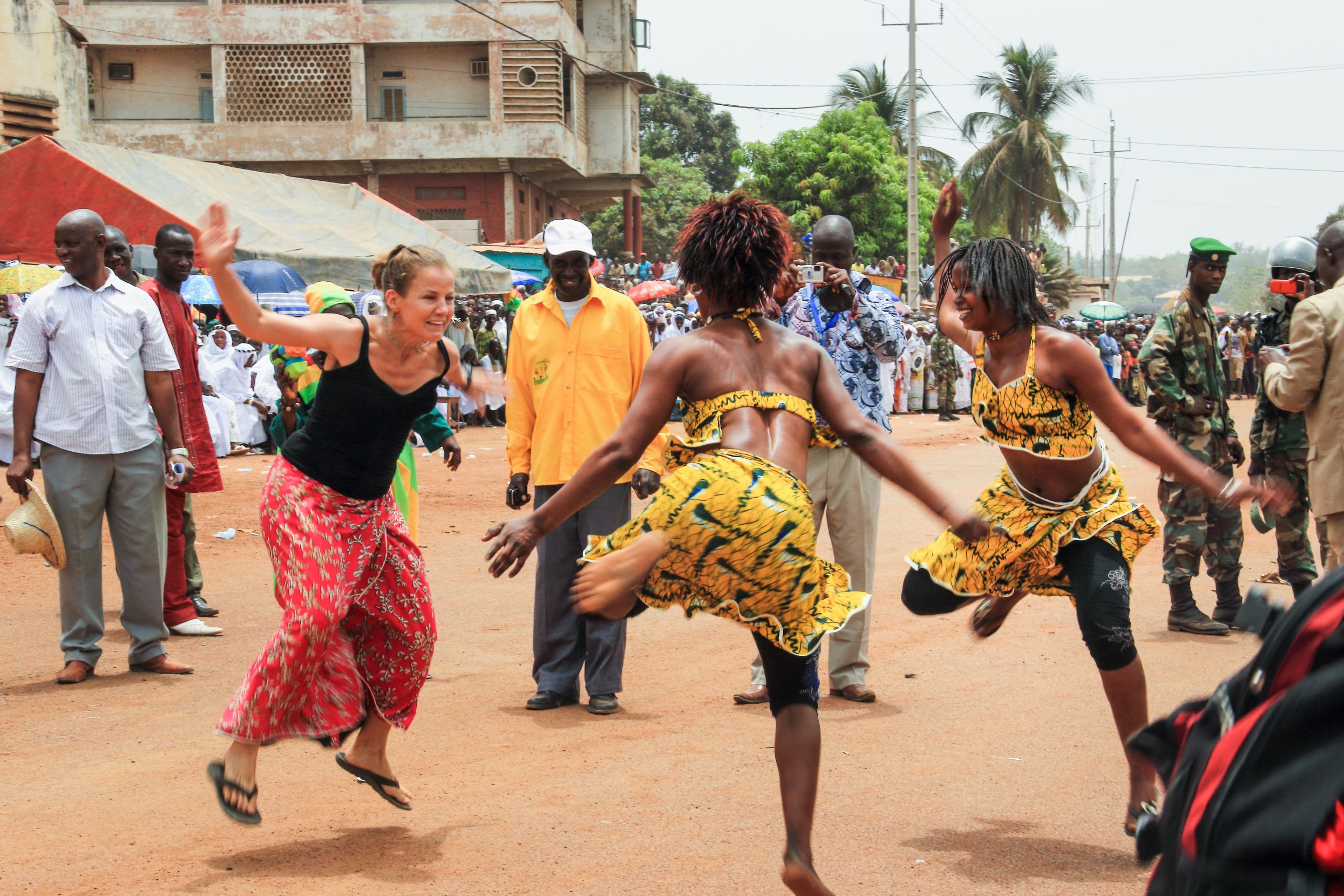
Women dance together in the street during a festival celebrating music and dance in Faranah, Guinea. Photo: Lilli Rannikko.
I marveled at this ubiquity of the arts as I walked through local neighborhoods. On a visit to Matam, I tracked the sound of drums to a crumbling maison des jeunes, where a local performance group was practicing.
Days into my trip, I reached a realization: In the same way I trusted the inevitability of coming across a Starbucks back home, I was beginning to trust I could find music and dancing in any neighborhood here. Artistic inspiration seemed to seep from every crack in the cement buildings that dotted the city.
~~
Upon Guinea’s independence from French colonial rule in 1958, LBA accepted the invitation of the newly appointed Guinean president, Sekou Ahmed Touré, to return and serve as key influencers. Touré and his government had decided to make the arts a top national priority. Fodéba, who had been vocal about anti-colonial sentiments, became a political ally of Touré.
Touré’s effort to expand artistic education and practice seemed to have had its intended effect. But while the popularity of the arts and honoring of traditions had only expanded over time, LBA itself had not fared as well.
In 1984, when Touré died, things quickly went downhill for the group. Money for salaries and tours all but evaporated. With many of the artists desperate to make a living, some defected on tours. Without support, LBA’s founding mission to share West African arts globally became increasingly difficult.
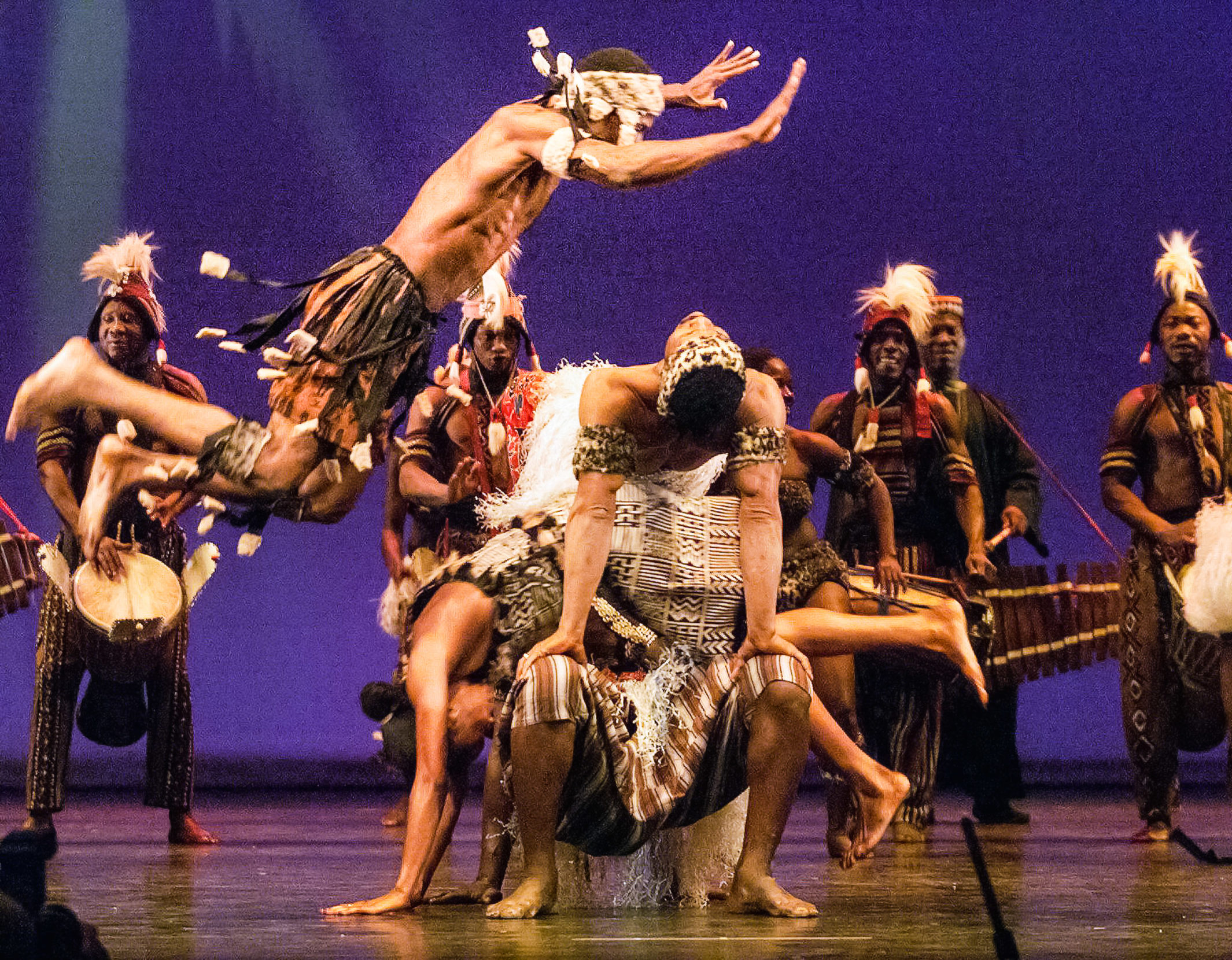
The acrobatic artistry of Les Ballets Africains takes center stage at Melbourne’s State Theatre during an international tour by the ensemble in 1999. Photo: Reuters/Alamy.
Training with the current ensemble’s elite dancers now typically meant traveling to West Africa, and many people’s only exposure to the group was through outdated YouTube clips — ones I had watched time and again before my own arrival in Conakry.
To supplement their tiny, state-funded salaries, each of the LBA performers made money in other ways. Mamadama, for instance, starred in popular local TV programs. Others worked at local shops or the airport. These intrepid dancers continued to rehearse, recruit, and perform despite long hours and little money. Their passion and commitment humbled me.
~~
I had quickly discovered in class that there was no “5, 6, 7, 8.” Instead, we took our cues from the drums. The lead djembe player would signal he was ready for the next dance move by playing a “break” — a specific rhythm unique to each song that signals a change (and which Fodéba created so that performers on stage moved in unison).
Continuing to dance, while also listening for the break, required my full focus.
After learning seven different doundounba moves, the time came to try the choreography with music. At first, the musicians kept the tempo at a manageable pace. Still, by the time we ran through the choreography three times, my body was begging for class to be over. I sat down on the ground, breathing hard, my face bright red.
The drummers weren’t interested in my fatigue. Immediately, they began to play the song at a faster tempo.
“Let’s go!” one called.
It was not a request. For a moment, I felt a surge of energy. They were playing faster. We would dance faster!
Do I typically stop before I need to? I wondered. Do I know what it means to give myself entirely to a dance?
The answer was no. I had been taught to save my energy. There would always be another opportunity.
Here, preserving energy for later did not seem to be part of the tradition — and even seemed like an impediment to the dance.
At doundounba gatherings in the city, I watched people enter the circle as they felt inspired and throw down, bringing their talent, emotion, and power to the moment. When finished, they would return to the crowd. Sooner or later, another dancer would take their place.
In this way, it seemed to me, a person could give each step the full energy the dance warranted. Realizing this felt as essential as figuring out the moves.
A sense of understanding, though, could only come from experiencing this call and response in action.
~~
The van’s headlights illuminated every pothole in the dirt road and the sepia landscape around us. As the vehicle teeter-tottered along, I held onto its old, dusty seats in an attempt to stay upright.
After two weeks of dance classes, we had headed out to the countryside with a van full of dancers. Four hours of driving on bumpy roads had delivered us to our destination: a camping spot beneath a towering waterfall.
Now far outside Conakry, I assumed we had left the arts behind.
As we set up our tent, however, the tinny sound of a balafon — projected over a loudspeaker somewhere off in the distance — made its way to us.
“There’s dancing out there,” I said excitedly, putting down the tent poles. “We need to find it!”
Mamadama and my fellow travelers were in.
Climbing back into our beige, beat-up van, we set off just as the sun was disappearing over the horizon.
The windows were down and we listened intently, following the sonorous music through the increasing blackness of the encroaching night.
“Do people dance a lot outside urban areas, too?” I asked Mamadama, who sat by my side in the backseat.
“Yes,” she replied. “This is normal. We dance for many reasons: weddings, birthdays, funerals, or any other important gathering.”
“What sort of event do you think is happening right now?”
Mamadama was quiet for a moment, listening to the balafon.
“They are playing the rhythm Mané,” she said. “So it could be a marriage ceremony.”
Ten minutes later, we arrived at the outskirts of a small village. We piled out of the van and made our way past mud-brick houses with thatched roofs. People had gathered in a circle at the center of the community, with the musicians at the far end. One man struck a melody on the balafon with two large mallets, while several others played percussion.
The expression of dance unfolding before me seemed to be guided by so much more than the rhythm of the drum.
Like in the gatherings I’d seen in Conakry, people moved in and out of the space organically. Sometimes, there was only one dancer in the middle. Other times, inspired audience members would join, mirroring her movement with vigor until the energy crescendoed and the dancers dispersed back into the outskirts of the crowd.
Initially, my companions and I stood at the back of the circle, trying to be polite. Once the locals realized we were there, however, they ushered us to sit in the front row. Not long after, we were pushed into the center to dance.
The people around us smiled and giggled, waving us farther into the circle.
Luckily, Mamadama was with us. She led the way, modeling rhythm-appropriate movements at half speed so we could follow. The crowd around us yelled their support, although it was difficult to hear them. We danced in front of the speakers, and the sound of the balafon and drums was almost deafening.
Then, in an instant, Mamadama was gone — bolting off toward the musicians with her green skirt flying wildly around her.
I watched in admiration as she looked the drummers in the eyes, directing their music through her dancing and allowing their rhythms to inspire her in return.
I looked around, wondering if anyone recognized Mamadama’s celebrity, but the crowd’s reaction appeared the same as it had been with others.
Like many dancers before her, Mamadama had taken her turn in the center for a few joyful minutes — and then melted back into the scene.
~~
During those fleeting moments when all eyes were on her, Mamadama wasn’t showing off. She had simply accepted the invitation offered by the community and the music. It was something she’d done countless times before, since she was a young woman.
On my first dance class in Conakry, I had watched the children dancing by our side. Soon, I knew, their skill would far surpass mine. They would grow up learning traditional songs, including during neighborhood visits from the djeli, the oral historians of West Africa. The cultural meaning would be as much a part of them as the motions.
Keïta Fodéba drew from a similar depth of experience when he created choreography for Les Ballets Africains that energized audiences worldwide. The expression of that cultural richness has adapted to new audiences and surroundings around the globe — in celebration and in resistance — and inspired generations of artists, myself included.
Yet, no matter how comfortable I get with the rhythms and pace of West African dance, my expression will never compare to the depth of Mamadama or the other artists I met in Guinea. It’s not my art form, nor my lived experience, to express. But to bear witness is to accept that, like any call and response, it’s an invitation to be moved.
Megan Taylor Morrison
Megan Taylor Morrison is a best-selling author, semi-professional dancer, and certified business coach.
Never miss a story
Subscribe for new issue alerts.
By submitting this form, you consent to receive updates from Hidden Compass regarding new issues and other ongoing promotions such as workshop opportunities. Please refer to our Privacy Policy for more information.

